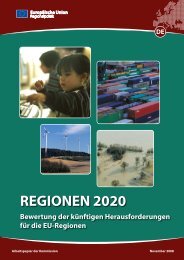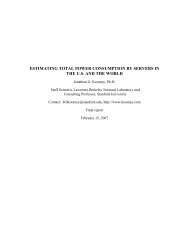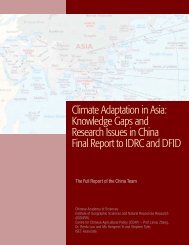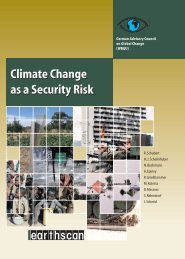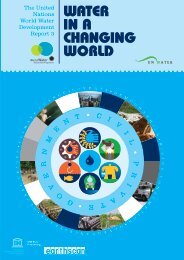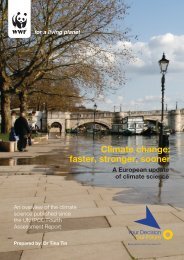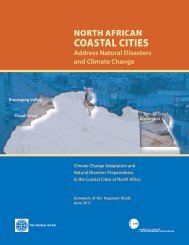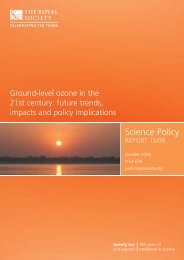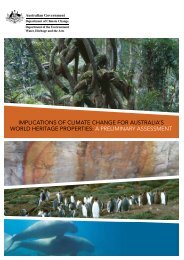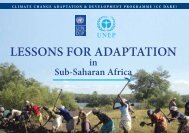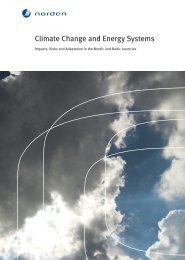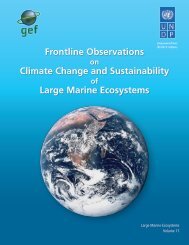NATURAL AND MANAGED SYSTEMSadelgid that is migrating northward with warmer winters(Parker et al. 1998; D. Foster, Harvard Forest,pers. comm., 2005).THE ROLE OF CLIMATEFORESTSDROUGHT, BEETLES AND WILDFIRESPaul EpsteinGary TaborEvan MillsBACKGROUNDA delicate balance exists between trees, insects <strong>and</strong>other animals in forested ecosystems. Now, globalwarming is upsetting that balance <strong>and</strong> leading toincreased tree devastation by insects. Among the mostdamaging is the spruce bark beetle (Dendroctonusrufipennis, Kirby) that primarily attacks EngelmannSpruce trees that grow from the Southwest US toAlaska. The mountain pine bark beetle (Dendroctonusponderosa) is another main pest of pine trees in westernNorth America, <strong>and</strong> its primary targets areLodgepole, Ponderosa, Sugar, <strong>and</strong> Western WhitePines. Another species (Dendroctonus pseudotsugae,Hopkins) attacks Douglas Firs preferentially. During thepast decade, these beetles have caused the destructionof millions of acres of pine trees in Western NorthAmerica. These infestations, coupled with decades offire suppression forest management, have increasedsusceptibility to forest fires from Arizona to Alaska.Similar infestations are occurring elsewhere in othertemperate regions in the US <strong>and</strong> abroad. The southernpine beetle attacks trees during drought conditions.Two beetle species account for over 90% of the barkbeetle infestations in the Great Lakes Region(Haberkern et al. 2002). In Eurasia, the Europeanspruce beetle (Ips typographaphus) does the mostdamage <strong>and</strong> attacks both stressed <strong>and</strong> unstressed trees(Malmstrom <strong>and</strong> Raff 2000).Meanwhile, other pests <strong>and</strong> pathogens are infectingtrees. In California, Phytophthora, a relative of theopportunistic fungus responsible for the Irish potatofamine, is causing “sudden oak death” in trees thatmay have been weakened by repetitive weatherextremes. In the Northeast US, hemlock conifers arebeing decimated by an aphid-like bug called theWhen weakened by drought <strong>and</strong> wilted by heat, treesbecome susceptible to pests (Kalkstein 1976; Mattson<strong>and</strong> Hack 1987; Boyer 1995). Normally, trees cankeep beetle populations in check by drowning themwith resin (or pitch) as they attempt to bore through thebark. Trees also allocate sugars to coat <strong>and</strong> wall offthe fungus carried by the beetles (Warring <strong>and</strong> Pitman1985). However, drought diminishes resin flow, <strong>and</strong>penetrating beetles introduce the fungus that causesdecay. The beetles then produce galleries of eggs thathatch into larvae that feed on the inner bark <strong>and</strong> girdlethe tree, leading to the tree’s death.While drought stress weakens the hosts (trees), warmingsimultaneously encourages the pests. With warmerwinters, the beetle reproductive cycle shortens, with theresult that beetle population growth outpaces that oftheir predators. Beetle populations can quadruple in ayear.Since 1994, mild winters have cut winter mortality ofbeetle larvae in Wyoming, for example, from 80% perannum to less than 10% (Holsten et al. 2000). InAlaska, spruce bark beetles are getting in extra generations<strong>and</strong> their life cycle is accelerating due to warming(Van Sickle 1995). There, they have stripped fourmillion acres of forests on the Kenai Peninsula (Egan2002). Warming is also exp<strong>and</strong>ing the range of beetles.Lodgepole Pines are the preferred target of themountain pine bark beetle; since 1998, the beetleshave attacked Whitebark Pine st<strong>and</strong>s that grow athigher elevations (8,000 feet or higher) (Stark 2002;Stark 2005).The cumulative effect of the multi-year drought in the USSouthwest from 1996-2003 <strong>and</strong> the series of warm,dry winters (leaving little snowpack) have facilitated asurge in bark beetle infestations <strong>and</strong> extensive tree mortalityacross the region. The prolonged <strong>and</strong> severedrought directly affected ponderosa pines (Pinus ponderosa),piñon-juniper woodl<strong>and</strong>s (Pinus edulis <strong>and</strong>Juniperus monosperma) <strong>and</strong> other trees, <strong>and</strong> increasedrates of soil erosion (Burkett et al. in press). In northernNew Mexico, piñon pine was severely impacted in2002 <strong>and</strong> 2003, with mortality surpassing 90% ofmature trees over a widespread area.65 | NATURAL AND MANAGED SYSTEMSCASE STUDIES
HEALTH AND ECOLOGICALIMPLICATIONSOutbreaks of the spruce bark beetle have causedextensive damage <strong>and</strong> mortality from Alaska toArizona <strong>and</strong> in every forest with substantial sprucest<strong>and</strong>s (Holsten et al. 2000). The dead st<strong>and</strong>s providesuperabundant kindling for lightning or human-inducedwildfires <strong>and</strong> are particularly vulnerable duringdrought. Wildfires are hazardous for wildlife, property<strong>and</strong> people, <strong>and</strong> they place dem<strong>and</strong>s on public <strong>health</strong><strong>and</strong> response systems. While some fires are natural<strong>and</strong> can have positive effects on vegetation <strong>and</strong> insectbuildup, extensive, cataclysmic-scale wildfires poseimmediate threats to firefighters <strong>and</strong> homeowners, <strong>and</strong>particles <strong>and</strong> chemicals from blazes <strong>and</strong> wind-carriedhazes cause heart <strong>and</strong> lung disease. Some fire byproducts(primarily from buildings) are carcinogenic.Hampshire. It is moving north with each warm winter.Those trees in Boston’s historic Arboretum, designed byFrederick Law Olmstead, have been drastically culledto try to control the infestation.Eastern Hemlock conifers play unique <strong>ecological</strong> roles.Hemlocks colonize poor soils <strong>and</strong> scramble to the crestsof mountains. Their arbors are umbrellas for resting deerin winter <strong>and</strong> the pine needles they shed nourish fish inthe deep forest streams they line. When st<strong>and</strong>s ofHemlocks die, their needles add large amounts of nitrogento the streams <strong>and</strong> tributaries, <strong>and</strong> the impacts oftheir loss is under intense study (Orwig <strong>and</strong> Foster2000; Snyder et al. 2002; Ross et al. 2003).Figure 2.23 Hemlock Wooly Adelgid66 | NATURAL AND MANAGED SYSTEMSCASE STUDIESLosing forests to fire also threatens the <strong>ecological</strong> servicesthey provide: a sink for carbon dioxide, a source ofoxygen, catchments (“sponges”) for flood waters, stabilizersof soils, habitat for wildlife <strong>and</strong>, via extensivewatersheds, clean water. As sources of evaporanspiration(evaporation, <strong>and</strong> transpiration through leaves) <strong>and</strong>cloud formation, forests are integral to local climateregimes <strong>and</strong> to the global climate system. The resilienceof large areas of boreal spruce forests that have succumbedto beetle infestations, with resulting large-scalediebacks <strong>and</strong> fire, are not well understood.Figure 2.22 Spruce TreesDead st<strong>and</strong>s of spruce trees infested with bark beetles.Image: Natural Resources Canada, Canadian Forest ServiceHemlock Wooly AdelgidWooly adelgid poses a risk to New Engl<strong>and</strong> foreststoday. This aphid-like bug has already infected EasternHemlock trees in Connecticut, Rhode Isl<strong>and</strong> <strong>and</strong>,Massachusetts, <strong>and</strong> has moved into southern NewImage: Dr. Mark McClure, CT Agricultural Experiment StationECONOMIC DIMENSIONSAccording to the US Department of Agriculture ForestService (Holsten et al. 2000), more than 2.3 millionacres of spruce forests were infested in Alaska from1993 to 2000 <strong>and</strong> the infestation killed an estimated30 million trees per year at the peak of the outbreak.The Kenai Peninsula in Alaska, Anchorage’s playground,is a devastated forest zone. In Utah, thespruce beetle has infested more than 122,000 acres<strong>and</strong> killed over 3,000,000 spruce trees. The losseshave amounted to 333 million to 500 million boardfeet of spruce saw timber annually. Similar losses havebeen recorded in Montana, Idaho <strong>and</strong> Arizona, withestimates of over three billion board feet lost in Alaska,<strong>and</strong> the same in British Columbia.In British Columbia, nearly 22 million acres of Lodgepole pine have become infested — enough timber tobuild 3.3 million homes or supply the entire US housingmarket for two years (The Economist 9 Aug 2003).In the summer <strong>and</strong> fall of 2003 the wildfires cost morethan US $3 billion (Flam 2004). The loss of tree cover
- Page 1 and 2:
Climate Change FuturesHealth, Ecolo
- Page 4 and 5:
Table of ContentsIntroductionPart I
- Page 6 and 7:
EXECUTIVE SUMMARYClimate is the con
- Page 8 and 9:
the past decade, an increasing prop
- Page 10 and 11:
THE CASE STUDIES IN BRIEFInfectious
- Page 12 and 13:
THE INSURER’S OVERVIEW:A UNIQUE P
- Page 14:
Regulators and governments can empl
- Page 17 and 18: THE PROBLEM:CLIMATE IS CHANGING, FA
- Page 19 and 20: Figure 1.3 GreenlandEXTREMESOne of
- Page 21 and 22: 20 | THE CLIMATE CONTEXT TODAYWholl
- Page 23 and 24: Figure 1.5 Global Weather-Related L
- Page 25 and 26: Climate signals in rising costs fro
- Page 27 and 28: CLIMATE CHANGE CANOCCUR ABRUPTLYPer
- Page 29 and 30: 28 | THE CLIMATE CONTEXT TODAYCCF-I
- Page 31 and 32: communities, salinizing ground wate
- Page 33 and 34: Health is the final common pathway
- Page 35 and 36: 34 | INFECTIOUS AND RESPIRATORY DIS
- Page 37 and 38: Figure 2.4 Malaria and Floods in Mo
- Page 39 and 40: Figure 2.61920-1980CASE STUDIES38 |
- Page 41 and 42: A MALARIA SUCCESSThe New York Times
- Page 43 and 44: A new flavivirus, Usutu, akin to WN
- Page 45 and 46: 44 | INFECTIOUS AND RESPIRATORY DIS
- Page 47 and 48: One analysis (Vanderhoof and Vander
- Page 49 and 50: BIODIVERSITYBUFFERS AGAINSTTHE SPRE
- Page 51 and 52: Figure 2.15 RagweedMOLDSLong-term f
- Page 53 and 54: ASTHMA COSTSTODAYexamples, the Afri
- Page 55 and 56: Stott et al. (2004) calculate that
- Page 57 and 58: In the summer of 2005, northern Spa
- Page 59 and 60: a better understanding of subpopula
- Page 61 and 62: 60 | EXTREME WEATHER EVENTSFLOODSFO
- Page 63 and 64: MOSQUITO- AND SOIL-BORNE DISEASESEC
- Page 65: Table 2.2 Direct and Indirect Healt
- Page 69 and 70: 68 | NATURAL AND MANAGED SYSTEMSCAS
- Page 71 and 72: Figure 2.27 Soybean Sudden Death Sy
- Page 73 and 74: 72 | NATURAL AND MANAGED SYSTEMSCAS
- Page 75 and 76: 74 | NATURAL AND MANAGED SYSTEMSCAS
- Page 77 and 78: 76 | NATURAL AND MANAGED SYSTEMSCAS
- Page 79 and 80: 78 | NATURAL AND MANAGED SYSTEMSTHE
- Page 81 and 82: HARMFUL ALGALBLOOMSFigure 2.32 Red
- Page 83 and 84: 82 | NATURAL AND MANAGED SYSTEMSCAS
- Page 85 and 86: CASE STUDIES 84 | NATURAL AND MANAG
- Page 87 and 88: CASE STUDIES 86 | NATURAL AND MANAG
- Page 89 and 90: CASE STUDIES 88 | NATURAL AND MANAG
- Page 91 and 92: CASE STUDIES 90 | NATURAL AND MANAG
- Page 93 and 94: “Climate change is one of the wor
- Page 95 and 96: 94 | FINANCIAL IMPLICATIONS• Incr
- Page 97 and 98: Extreme weather events are a partic
- Page 99 and 100: 98 | FINANCIAL IMPLICATIONSTable 3.
- Page 101 and 102: 100 | FINANCIAL IMPLICATIONSdemand
- Page 103 and 104: 102 | FINANCIAL IMPLICATIONSClimate
- Page 105 and 106: These include:Solar Photovoltaic Pa
- Page 107 and 108: • Social and economic factors in
- Page 109 and 110: Finally, new technologies need to b
- Page 111 and 112: 110 | FINANCIAL IMPLICATIONSBRETTON
- Page 113: 112 | APPENDICESAppendix A. Summary
- Page 116 and 117:
Table B.1 Summer Percentage Frequen
- Page 118 and 119:
Climate sensitivity for small-scale
- Page 120 and 121:
diffuse and do not manifest in sing
- Page 122 and 123:
APPENDIX D.LIST OF PARTICIPANTS ATT
- Page 124:
Carmenza RobledoGruppe OekologieEMP
- Page 127 and 128:
126 | BIBLIOGRAPHYBibliographyAAAAI
- Page 129 and 130:
128 | BIBLIOGRAPHYChordas, L. Epide
- Page 131 and 132:
Ford, S.E. & Tripp, M.R. Diseases a
- Page 133 and 134:
132 | BIBLIOGRAPHYKalkstein, L. S.,
- Page 135 and 136:
134 | BIBLIOGRAPHYMills, E. The ins
- Page 137 and 138:
136 | BIBLIOGRAPHYRose, J. B., Epst
- Page 139 and 140:
138 | BIBLIOGRAPHYVandyk, J. K., Ba
- Page 142:
Infectious and Respiratory Diseases



